
Environmental sustainability is steadily becoming a more critical issue for both consumers and animal agriculture. But, what does the science say about poultry’s impact on the planet?
As part of the International Poultry Council’s (IPC) First Semester Conference in New Orleans, Dennis Erpelding, chairman of Global Farm View LLC and the IPC’s science advisor, shared recent scientific data on the climate impact of livestock and where meat fits into a healthy diet. He spoke on April 17.
What does sustainability mean?
The challenge before humanity, and agriculture, is maintaining a growing population on a planet with finite resources and a warming climate. Politically, much of these global goals are defined by the United Nations’ (UN) Sustainable Development Goals and the articles of the 2016 Paris Agreement on global climate change.
Erpelding said the highlights of those policies are sustaining life on land, providing enough nutritious food for humanity and keeping the global temperature from rising by 2 degrees Celsius. He said these key aspects are driving global sustainability initiatives and, potentially, the transformation of agriculture itself.
Meat consumption and the environment
Discussion is growing around reducing the consumption of meat to help the environment. Proponents of this thought say livestock contributes a significant portion of planet warming greenhouse gases, so eating less reduces an individual’s carbon footprint.
This precept was expanded upon as part of a multi-part report released by The EAT-Lancet Commission early in 2019. That report said the ideal diet to protect the earth was centered on plant-based foods and reducing overall meat consumption.
Erpelding said that report was deeply flawed. It was financed and undertaken by actors with an anti-animal agriculture or vegetarian agenda. Moreover, the study was panned by non-governmental organizations like the World Wildlife Fund (WWF) and academics for its oversimplification of a complex issue and for its lack of proof that following a diet it recommends is actually the best course of action for environmental sustainability.
He explained these vegan arguments function with some assumption that if you eliminate animal agriculture, animal feed could be diverted elsewhere. He said that’s false. A 2018 report by The Food and Agriculture Organization of the United Nations (FAO) he cited said 86% of livestock feed is not suitable for human consumption. Using otherwise inedible material, the same report said, livestock provides 18% of calories and 34% of protein globally.
Greenhouse gas emissions
It’s important to establish a baseline for animal agriculture's environmental impact. Erpelding referenced a 2013 report by the FAO which said chickens accounted for the lowest amount of emissions among other livestock animals including beef cattle, dairy cattle, pigs and buffalo. This shows the global industry is already well positioned in terms of sustainability.
He reviewed data from a number of sources including the U.S. Environmental Protection Agency (EPA), the FAO, and the Intergovernmental Panel on Climate Change. The data showed that globally agriculture, forestry and other land use in that category accounts for 24% of greenhouse gas emissions. In the U.S., according to the EPA, agriculture accounts for 9%, which Erpelding said may be closer to global emissions for the sector.

In 2016, agriculture was the smallest component of U.S. emissions by sector.
Since the 1970s, agriculture’s overall contribution of greenhouse gases has remained relatively steady while other human activities’ – transportation, industry, and energy (electricity, heating, etc.) – output all increased over time. Chicken, specifically, decreased its emissions thanks to the industry’s steadily increasing efficiency.
The role of meat in a healthy diet
Meat’s health impact is also much maligned in the popular mind. The belief is red meat and processed meat are bad for you. But, what actually kills people? Erpelding reviewed another report – this one financed by the Bill and Melinda Gates Foundation – that looked into what global dietary trends were associated with pre-mature death.
The study identified three key factors: high intake of sodium; low intake of whole grains and low intake of fruits. Conversely, from a dietary risk comparative ranking, it found both the mortality rate and the number of deaths at the global level attributable to diet were the lowest in diets high in red meat, low in milk and high in processed meat.
Erpelding said this report should be better publicized and studied to help understand what role food truly plays in our health. He said it could play a significant role in a crafting a scientifically proven sustainable, healthy diet for humanity.
The role of the poultry industry
Poultry, as a nutritious and sustainable protein, will play a role in the diet of the future. Erpelding made these recommendations:
- Consider the sustainable development goals: Poultry companies should consider the UN’s goals as part of their overall vision on sustainability.
- Follow all the science, but think critically: The industry should follow the science and make science-based decisions. However, it must not forget to consider the source of the study, its methodology and it’s financing, too. Those factors can influence outcomes.
- Share the economic impact of poultry: Poultry’s economic impact, from small farmers to international corporations, is massive. Sharing that data with consumers and policy makers is important to building the discussion surrounding the industry.
- Get a seat at the table with politicians: Governmental organizations will play a role in sustainability going forward, so the industry should proactively reach out in order stay in the policy discussions that impact it.


















